#regina resnik
Explore tagged Tumblr posts
Text

Opera Society of Washington - Menotti's The Medium - Vinyl - LP - Columbia rec. - 1971
#witches#mediums#occult#vintage#menotti's the medium#gian carlo menotti#the medium#vinyl#columbia records#opera society of washington#regina resnik#jorge mester#judith blegen#1971#opera
45 notes
·
View notes
Text
Happy birthday Regina Resnik
0 notes
Text

























From the Golden Age of Television
Episode dated May 25, 1954
The Goldbergs - Music Lover - DuMont - May 25, 1954
Sitcom
Running Time: 30 minutes
Written by Gertrude Berg
Produced by Henry Opperman
Directed by Martin Magner
Stars:
Gertrude Berg as Molly Goldberg
Eli Mintz as Uncle David
Arlene McQuade as Rosie Goldberg
Tom Taylor as Sammy Goldberg
Robert H. Harris as Jake Goldberg
Ben Astar as Mr. Vargas
Dora Weissman as Mrs. Herman
Gene Leonard as The Critic
Regina Resnik as Eva Vargas
Leo Taubman At the piano
#Music Lover#TV#The Goldbergs#Sitcom#DuMont#1950's#1954#Gertrude Berg#Eli Mintz#Arlene McQuade#Tom Taylor#Robert Astar#Ben Astar#Regina Resnik
0 notes
Text
Cabaret's Shifting Lead Placement
Welcome to another rambling theatre history lesson with DroughtofApathy. Today we're going to examining the fascinating history of Cabaret's ever-changing lead roles.
Ground rule: Tony eligibility for Lead Actor/Actress is first determined by "above-the-title" billing in the show's opening night Playbill. It was a far stricter guideline in the past, as you'll see. These days, many lead roles aren't put above the title (ex. Hadestown, Kimberly Akimbo, etc.) but will be placed in lead categories either because it's obviously a lead, or because producers lobby for it. Conversely, actors can have "above-the-title" billing and be in featured roles, usually because they're major names like Angela Lansbury and Elaine Stritch, who were both Madame Armfeldt in the 2009/2011 revival of A Little Night Music. In which case, producers will usually submit them as featured.
When Cabaret opened on Broadway in 1966, Jill Haworth (Sally), Jack Gilford (Herr Schultz), and Bert Convey (Cliff) got top billing with Lotte Lenya (Fraulein Schneider) in the coveted "and" slot just below. Note who's missing. That's right. When the show premiered, Joel Grey (Emcee) was just a regular old featured role.
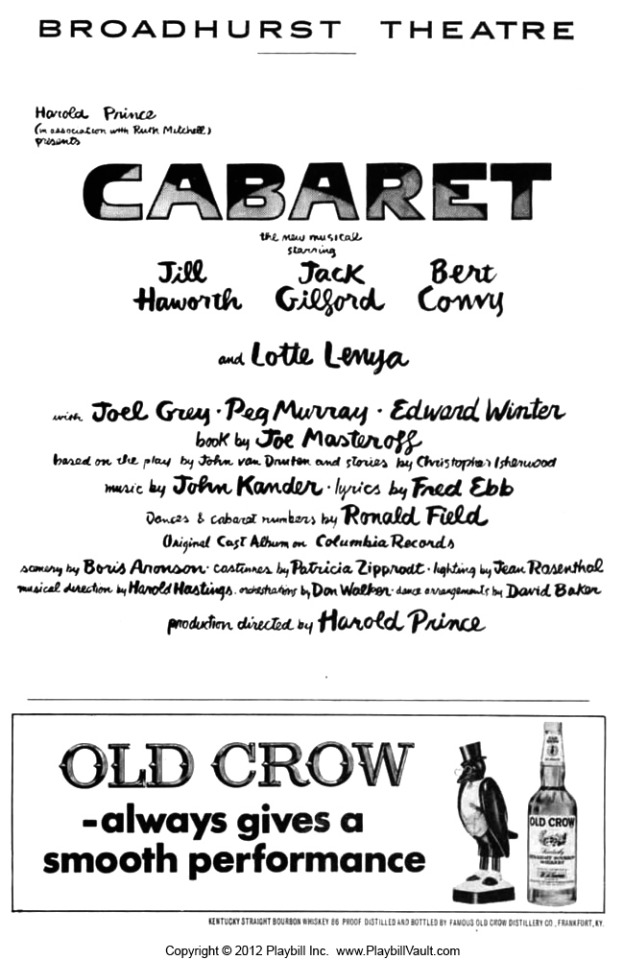

Left: opening night playbill billing. Right: post-Tony rebilling with Joel Grey's ascension.
At the 1967 Tonys, Jack Gilford (Herr Schultz) and Lotte Lenya (Fraulein Schneider) were nominated as Leading Actor/Actress, respectively, while Joel Grey and Edward Winter (Ernst Ludwig) were both in Featured. Jill Haworth (Sally) was not nominated, but would have been eligible for Lead as she had "above-the-title" billing. At the time, Joel Grey was just another working actor. Not so after Cabaret. His performance elevated both the role and his billing, thus transforming the Emcee into a Leading Role from then on.
Subsequent productions would focus more on Sally and the Emcee, while Schultz and Schneider (and the non-singing Cliff) would become featured roles. However, the "above the title" Tony ruling was far stricter back in the day, leading Sally (this time Alyson Reed) to once more be featured in the 1987 revival.


Left: opening night Playbill billing. Right: poster billing
In 1987, Joel Grey was given the sole "above-the-title" billing with Alyson Reed in the next featured spot. Though Sally was, like 1966, technically a lead role, she was nominated in featured at the Tonys that season. (Grey was not eligible as he was reprising his role.) In this production, Regina Resnik (Schneider) and Werner Klemperer (Schultz) both got fancy featured billing and nominations in their respective categories. As Cliff, Gregg Edelman got the "and" billing, but in this case it was less elevated than either Resnik or Klemperer (note the boxes). Edelman was still early-career at this point, and not yet a "name" but Cliff was still considered an elevated role in the company.
By 1998, however, the roles as we currently think of them had finally slotted into place. Alan Cumming (Emcee) won for Best Actor, Natasha Richardson (Sally) for Best Actress and Ron Rifkin (Schultz) for Featured Actor. Mary Louise Wilson (Schneider) was nominated in Featured Actress. Richardson also received left-side billing, as she was a larger name (arguably) than Cumming at the time.
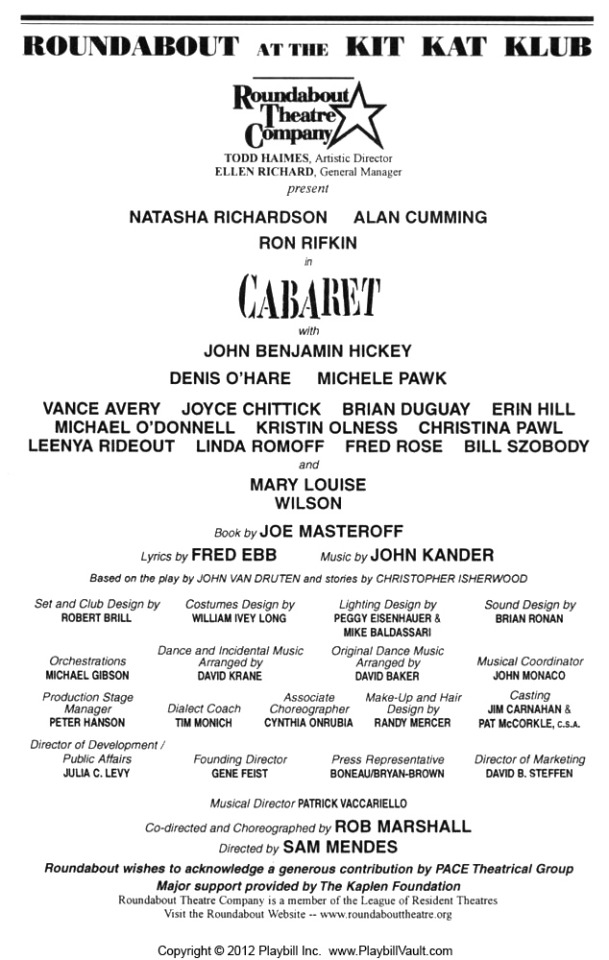
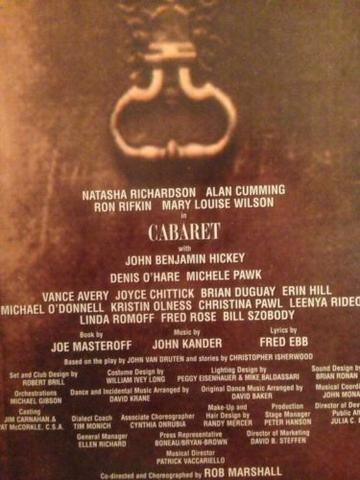
Left: opening night Playbill billing. Right: lobby poster billing
But though nominations seemed to make sense, it still didn't jive with billing placement. In the 1998 production, Richardson, Cumming, and Rifkin all had "above-the-title" with Wilson in the featured "and" slot. Despite this placement, Rifkin went in for Featured. Producers can lobby the Tony committee for actor placement if they think it fitting, and these days we're a lot more fast-and-loose with the definitions. Note however, how Wilson has "above-the-title" billing in the lobby board. This was presumably a contractual renegotiation that happened post-Tonys. Note how Denis O'Hare (Ernst) and Michele Pawk (Kost) have their own line below John Benjamin Hickey (Cliff). All three were/are modest, but known, names in the theatre world, about equal to one another, at least at the time.
By 2014, the old couple (Schultz and Schneider) no longer would get top billing. Alan Cumming only built upon Joel Grey's foundation to fully elevate the Emcee role into the undisputed leading man, with Sally the star-vehicle leading lady. Between the 1998 and up until the recent revival, the older couple's story--and Cliff's importance--had taken a backseat.
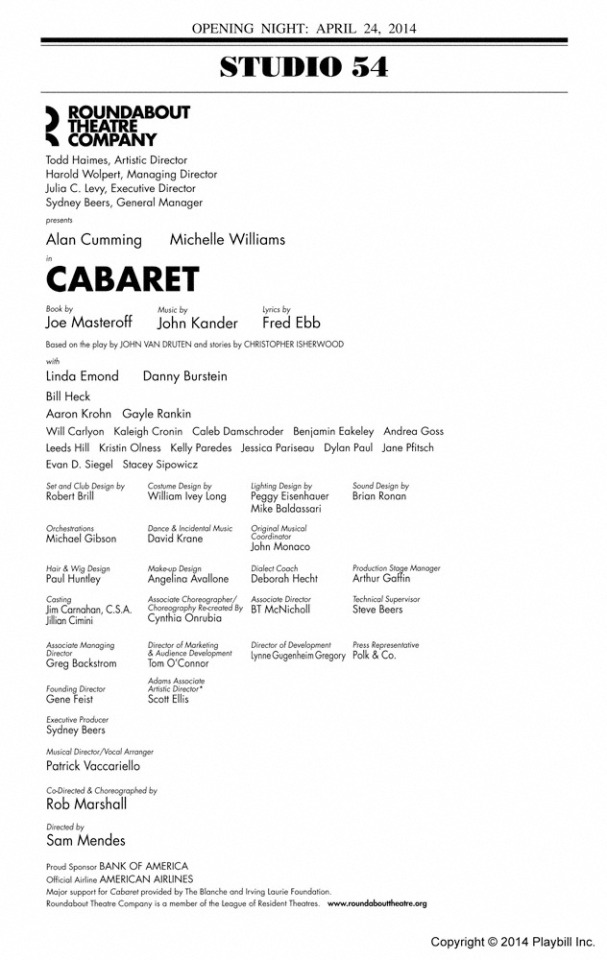

Left: opening night Playbill billing. Right: poster billing.
In 2014, the revival won no Tonys, but was nominated for both Featured Actor and Actress (Danny Burstein and Linda Emond, respectively). Cumming was not eligible as, like Joel Grey before him, he was reprising his role. This time, with a Tony in his pocket, and a much bigger name than 16 years prior, he got left-side billing. Emond and Burstein received equal line billing below the title, with Emond getting the left. Though they were roughly equal in the theatre world, and Burstein had a slight edge in terms of Tony noms, I'd guess Emond got the left owing to her larger screen presence/notoriety. In the poster, Bill Heck (Cliff) is left out of featured billing entirely, as are Aaron Krohn (Ernst) and Gayle Rankin (Kost).
Now we come to our latest revival, number four. Though it's still too early for nominations, we can assume Eddie Redmayne (Emcee) and Gayle Rankin (Sally) will be leads with all others featured. Historically, Schultz and Schneider are roles that receive nominations, and the Emcee a role that wins. Will that hold in a wildly over-crowded season?
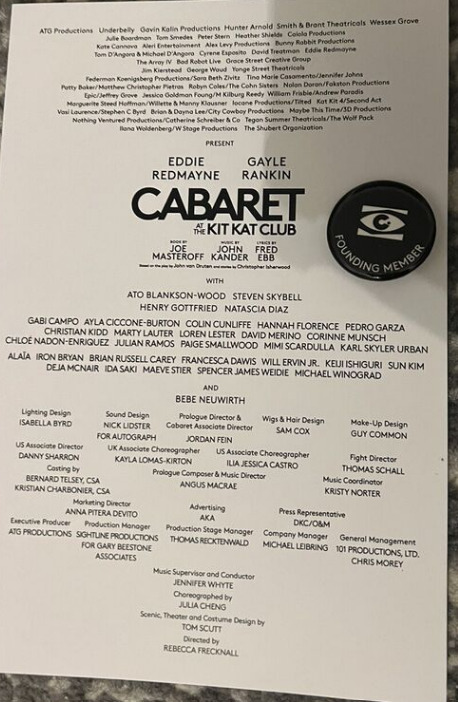
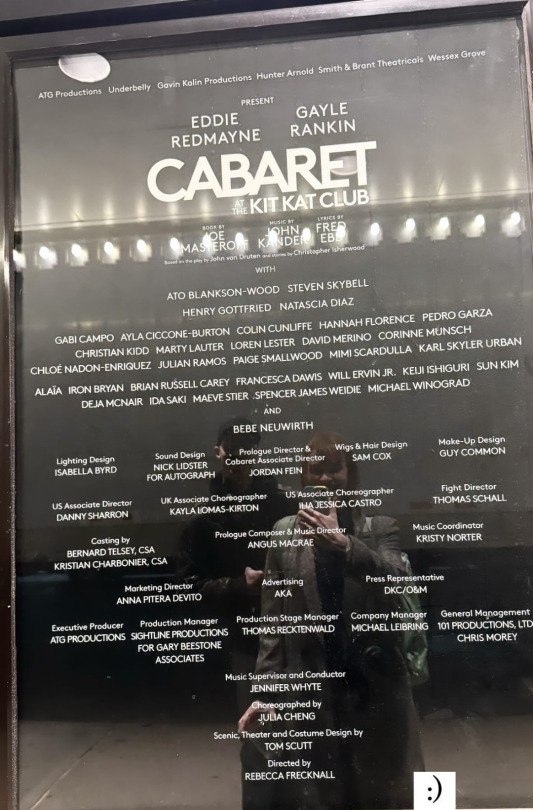
Left: first preview Playbill insert. Right: billing poster outside the theater.
Once more deviating from past productions, the roles of Cliff (Ato Blankson-Wood), Ernst (Henry Gottfried), and Kost (Natascia Diaz) are plucked back out of the company to be given featured billing. This time, Steven Skybell (Schultz) is on even footing with Cliff, even slightly under with his right-side billing. This would be the least "elevated" billing any Schultz has ever gotten. Skybell is a respected theatre veteran but not quite a household name, even in theatre circles. Blankson-Wood, meanwhile, is a recent Tony nominee. It's all politics when it comes to billing.
Here, Bebe Neuwirth (Schneider) is given the coveted "and" poster billing, no surprise. Of the featured roles, she's inarguably the biggest name. A few decades ago, that might have been enough to get her above the title, but these days it's less common that a solidly featured role would get that (unless you're Patti LuPone in Company, and Bebe doesn't have quite the same sway or ego).
This, to me, seems like the most obvious case of industry politics and agent negotiation at play, and usually actors (and egos) aren't even involved in the conversation. Skybell and Neuwirth aren't on the same level, though their characters are. My guess here is that producers want to bill their sole two-time Tony winner separately, and Skybell's agents know he isn't big enough to dispute that.

Now, let's take a look at this marketing design. Redmayne's name is left-billed despite being above Rankin's head. While annoying for those of us audience members who might just see this as a design flaw, this is all contractual, negotiated to death. Redmayne also gets front-and-center positioning, while Rankin is in the background, off-center, but she gets left-side position, which isn't as minimizing as right-side would. Left-billing is given to the bigger name because English reads left to right. These are the kinds of things I think about when I see marketing ads and playbills.
#cabaret#cabaret broadway#history lessons with doa#ask me about the sweeney todd teaser key art please it's an even better example of contracts at play#yeah i *did* stalk the ebay pages until someone put a playbill picture up for listing i'm just that dedicated to the craft#bebe neuwirth#joel grey#alan cumming#it's 9:30 a.m. but we're going live with this because why the fuck not?
24 notes
·
View notes
Text

July 9, 1991: NY City Opera opens its 47th season with Night Music at the NY State Theatre with a cast including Sally Ann Howes and Regina Resnik.
10 notes
·
View notes
Text
Every time I’ve shown someone the 1990 recording of A Little Night Music they wonder if Regina Resnik is a man in drag so let’s hear it for a cisclocky broad in the high arts
4 notes
·
View notes
Text
The New York Public Library for the Performing Arts Celebrates the Centenary of Opera Singer Regina Resnik with a Exhibition
Regina Resnik, c. 1940s. Music & Recorded Sound Division The show celebrates the incredible and varied career of Resnik, and showcases her impact on the city that made her success possible—New York The New York Public Library for the Performing Arts at Lincoln Center celebrates the centenary anniversary of Regina Resnik with an exhibition, Regina Resnik, A New York Treasure, opening September…

View On WordPress
0 notes
Text
why don’t we have an HD remaster or at least an official version of the 1990 proshot of a little night music. it like aired once on pbs and never got a home release. the 360 p vhs rip on youtube is not doing it for me
#the reason is that nobody really cares that much#however the terrible terrible movie is also out of print#so hmmm how are we supposed to watch the show#side note the movie is SOOOO bad and my number one piece of evidence that#'oh phantom 2004 would have been perfect if hal prince directed' is FALSE#it probably would have been better because joel schumacher is an idiot#but hal prince did not speak film he only spoke theatre#regina resnik is DEFINITIVE tho
3 notes
·
View notes
Text
DER RING DES NIBELUNGEN BAYREUTH 1961 (Kempe:Nilsson,Varnay, Hines,Kraus,Hopf,Milligan,Crespin, Resnik...)
DER RING DES NIBELUNGEN BAYREUTH 1961 (Kempe:Nilsson,Varnay, Hines,Kraus,Hopf,Milligan,Crespin, Resnik…)

Després del darrer Ring de Hans Knappertsbusch amb la producció mítica de Wieland Wagner (1958) degudament perfeccionada al llarg d’una dècada miraculosa del Neue Bayreuth, dècada que ens va deixar el millor testament del cant wagnerià modern, només hi va haver una edició del festival sense Ring, ja que l’any 1960 es va estrenar la nova producció, ara amb Wolfgang Wagner com a responsable…
View On WordPress
#Astrid Varnay#Bayreuther Festpiele#Birgit Nilsson#Chor und Orchester der Bayreuther Festspiele#Der Ring des Nibelungen#Fritz Uhl#Gerhard Stolze#Gottlob Frick#Grace Hoffmann#Hans Hopf#Herold Kraus#James Milligan#Jerome Hines#Marga Höffgen#Otakar Kraus#Régine Crespin#Regina Resnik#Richard Wagner#Rudolf Kempe#Thomas Stewart#Wilma Schmidt
0 notes
Text
La diva sin ópera
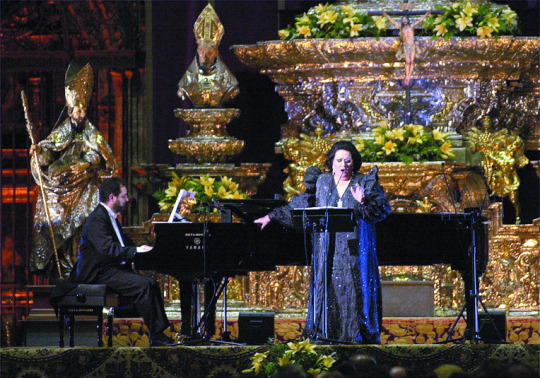
[Montserrat Caballé en un concierto en la catedral de Sevilla en el año 2000. La foto es de Juan Carlos Muñoz]
Sobre la larga y esquiva relación entre Caballé y Sevilla
Montserrat Caballé nunca cantó una ópera completa en Sevilla. Este será sin duda uno de los grandes estigmas con el que habrán de cargar los gestores y programadores líricos de la ciudad, no haber logrado que una de las más grandes estrellas del firmamento operístico de la segunda mitad del siglo XX encarnase a alguna de sus grandes heroínas en las tablas sevillanas. Y no es porque no la tuvieran cerca ni porque a la soprano le faltaran gestos de simpatía hacia la ciudad. Por lo que fuera, el hecho queda para la historia de las ausencias.
Nunca cantó una ópera en escena, pero hay documentadas al menos una docena de actuaciones suyas en Sevilla, hasta en cinco escenarios diferentes. La soprano de los filados infinitos ofreció ya, junto a su fiel escudero Miguel Zanetti, un recital en el Lope de Vega en octubre de 1969. Habían pasado poco más de cuatro años de su despegue internacional, tras la mítica Lucrecia Borgia del Carnegie Hall. Las crónicas de la época hablan de asombro incomparable. Los años 70 son los años de la consolidación del prodigio en los teatros de todo el mundo. Años de adjetivos gastados por el uso. De apelaciones a herencias (la de la Callas) que ella misma siempre rechazó ("no, por favor, María es demasiado grande", decía).
Años también de penuria musical en Sevilla, que no volvió a escuchar en directo a la Caballé hasta mayo de 1984, cuando regresó al Lope de Vega en un recital de los de Cita en Sevilla, con lleno hasta en los pasillos. En 1990 repitió en el mismo mes, el mismo ciclo y el mismo escenario con dos nuevos recitales. Luego llegó el Maestranza, la Expo y las inauguraciones. Primero la del coliseo del Paseo Colón en la famosa Gala Lírica de mayo de 1991, compartiendo tablas con los grandes de la ópera española del momento (Aragall, Berganza, Carreras, Domingo, Kraus, Lavirgen, Lorengar, Pons); después con un recital en solitario en junio de aquel mismo año, aún dentro de los fastos por la apertura del teatro. Lamentablemente sus siguientes comparecencias en él fueron para ocasiones menores, siempre acompañada por su hija Montserrat Martí (1995, con la Orquesta Nacional de España dirigida por José Collado; 2002 y 2011, disminuidas ya considerablemente sus facultades vocales, en recitales benéficos). ¡Qué gran belcantista se perdió el teatro para una ópera de verdad, en una época (los 90) en la que sus medios eran aún notables!
Lo que mucha gente no sabe (o no recuerda) es que Caballé fue también protagonista en la inauguración del Teatro Central, que tuvo lugar el 20 de abril de 1992 con la recuperación de una obra teatral de Rafael Alberti (La Gallarda), que contó con la participación de Ana Belén y José Sacristán y en la que la soprano cantó música de Manolo Sanlúcar. Otro de los centros emblemáticos de las artes escénicas durante la Expo’92, el Auditorio de la Cartuja (hoy, Auditorio Rocío Jurado), vio también a Caballé en algunas funciones de la Antología de la Zarzuela, un género que prestigió más desde los recitales y las grabaciones que en funciones escénicas.
El quinto escenario sevillano que pisó la gran cantante catalana fue sacro. El 22 de mayo de 2000, en la inauguración del ciclo Ópera por Barrios, Caballé ofreció en la catedral, y junto al tenor Joaquín Pixán, un recital que oficialmente se había programado para el Monasterio de San Jerónimo y que hubo de ser aplazado once días por una caída sufrida por la soprano poco antes de coger el vuelo que la había de trasladar de Barcelona a Sevilla.
Montserrat Caballé, leyenda interminable del arte del canto, ha muerto. Y el mundo de la ópera llora. De las otras caídas que escriban otros.
[Diario de Sevilla. 7-10-2018]
UNA DISCOGRAFÍA INABARCABLE
Entre grabaciones oficiales de estudio, tomas en directo (a veces, piratas; a veces, radiofónicas; a veces, de sonido algo más que deficiente) y recopilaciones de todo pelaje, el legado discográfico de Montserrat Caballé es inmenso. En las más importantes casas discográficas y en las marcas corsarias más insospechadas, con los más grandes maestros de su tiempo (de Schippers, Bonynge y Muti a Mehta, Pritchard, Patané o Colin Davis) y en compañía de los cantantes más célebres (Pavarotti, Domingo, Carreras, Milnes, Ramey, Sutherland, Bergonzi, Capuccilli…), sus grabaciones circulan en todos los formatos físicos y digitales conocidos, plataformas de internet, tiendas y bazares de segunda mano.
Aunque destacó principalmente en el repertorio belcantista y verdiano, Caballé dejó también testimonios de obras veristas o de algunos de los más conocidos títulos del repertorio francés y fue una estupenda straussiana. La siguiente lista, escogida y ordenada por simple afinidad personal, quiere servir sólo de acicate para acercarse a su arte; es un mojarse los pies en la orilla del océano inmenso.
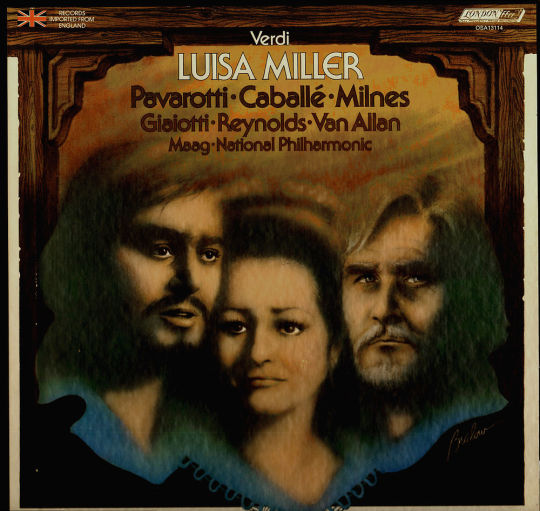
Verdi: Luisa Miller. Con Luciano Pavarotti y Sherrill Milnes. Dirección de Peter Maag. DECCA (1976)
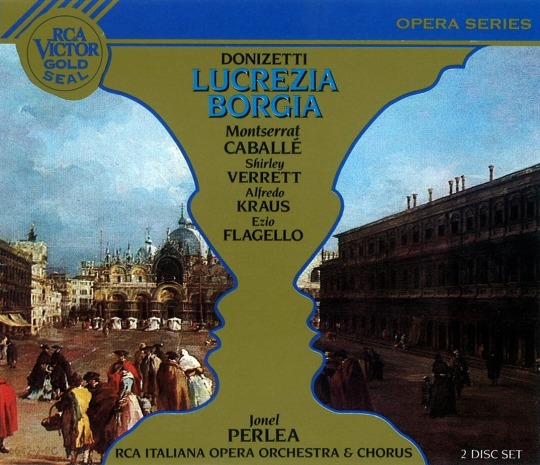
Donizetti: Lucrezia Borgia. Con Shirley Verrett, Alfredo Kraus y Ezio Flagello. Dirección de Jonel Perlea. RCA (1966)

Strauss: Salomé. Con Sherrill Milnes, Regina Resnik y James King. Dirección de Erich Leinsdorf. RCA (1968)

Verdi: Un ballo in maschera. Con José Carreras e Ingvar Wixell. Dirección de Colin Davis. PHILIPS (1979)
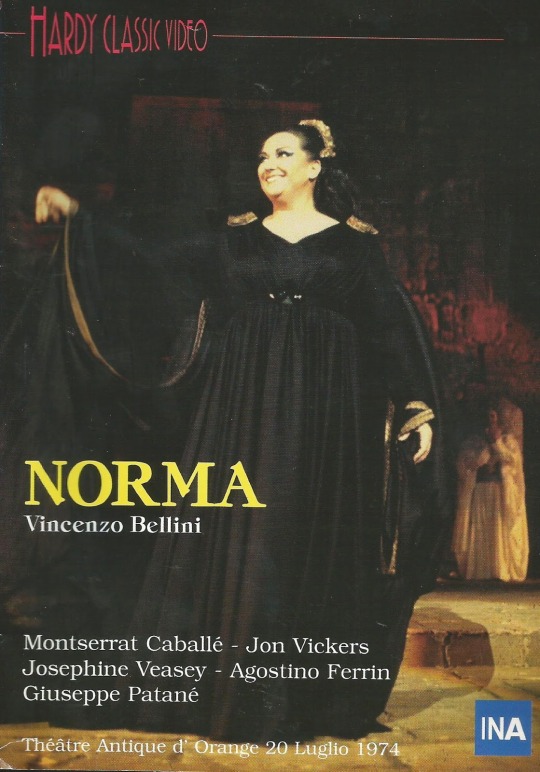
Bellini: Norma. Con Jon Vickers y Josephine Veasey. Dirección de Giuseppe Patané. DVD HARDY CLASSIC VIDEO (1974)

Leoncavallo. I Pagliacci. Con Plácido Domingo y Sherrill Milnes. Dirección de Nello Santi. RCA (1972)

Verdi: Aida. Con Plácido Domingo, Fiorenza Cossoto, Piero Capuccilli y Nicolai Ghiaurov. Dirección de Riccardo Muti. EMI (1974)

Strauss: Der Rosenkavalier. Con Otto Edelman, Teresa Zylis-Gara y Edith Mathis. Dirección de John Pritchard. GLYNDEBOURNE (1965)
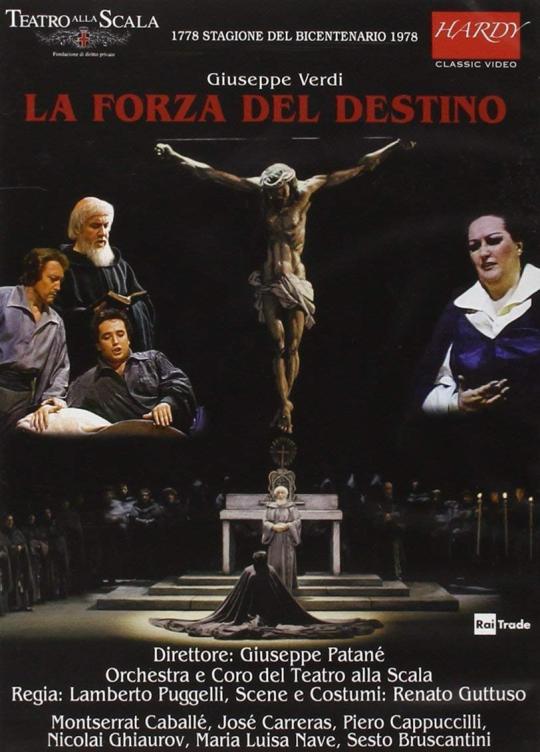
Verdi: La forza del destino. Con José Carreras, Piero Capuccilli, Nicolai Ghiaurov y Sesto Bruscantini. Dirección de Giuseppe Patané. DVD HARDY CLASSIC VIDEO
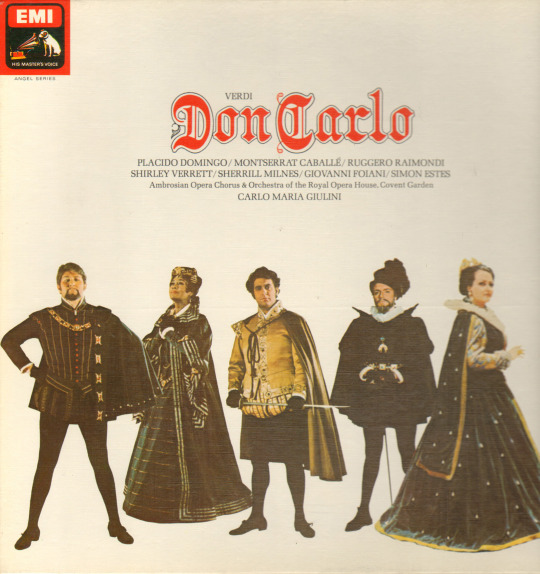
Verdi: Don Carlo. Con Plácido Domingo, Ruggiero Raimondi, Shirley Verrett, Sherrill Milnes y Simon Estes. Dirección de Carlo Maria Giulini. EMI (1970)

Cilea: Adriana Lecouvreur. Con José Carreras, Fiorenza Cossoto, Ivo Vinco y Piero de Palma. Dirección de Gianfranco Massini. DVD VAI (1976)

Verdi: Il trovatore. Con Richard Tucker y Mario Zanasi. Dirección de Thomas Schippers. NUOVA ERA (1969)
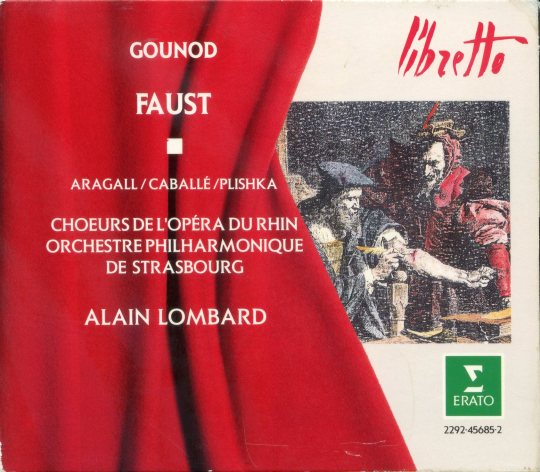
Gounod: Faust. Con Jaume Aragall y Paul Plishka. Dirección de Alain Lombard. ERATO (1976)
[Diario de Sevilla. 7-10-2018]
1 note
·
View note
Text
Happy birthday Regina Resnik
0 notes
Text
Mantovani

Kismet (Studio Cast) (1963)
Mantovani – 01 – a- Overture – Mantovani and his orchestra (4:10) Mantovani – 01 – b- Sands Of Time – Kenneth McKellar (1:51) Mantovani – 01 – c- Rhymes Have I – Robert Merrill and Adele Leigh (2:34) Mantovani – 02 – Fate – Robert Merrill (2:12) Mantovani – 03 – Baubles, Bangles And Beads – Adele Leigh (3:57) Mantovani – 04 – Not Since Ninevah – Regina Resnik and Ian Wallace (3:05) Mantovani – 05 – Stranger In Paradise – Kenneth McKellar and Adele Leigh (4:52) Mantovani – 06 – He’s In Love – Ian Wallace (2:25) Mantovani – 07 – Gesticulate – Robert Merrill and Regina Resnik (4:45) Mantovani – 08 – Night Of My Nights – Kenneth McKellar (2:38) Mantovani – 09 – Was I Wasir – Ian Wallace (2:12) Mantovani – 11 – And This Is My Beloved – Adele Leigh, Kenneth McKellar, Robert Merrill and Ian Wallacce (4:51) Mantovani – 12 – The Olive Tree – Robert Merrill (2:41) Mantovani – 13 – Zubbediya – Regina Resnik (1:15) Mantovani – 14 – Samaris Dance – Mantovani and his orchestra (1:16) Mantovani – 15 – Finale Act II – Robert Merrill, Kenneth McKellar and Adele Leigh (2:28)
Mantovani published first on https://soundwizreview.tumblr.com/
0 notes
Audio
2 notes
·
View notes
Text

Madame Armfeldt
Hermione Gingold (1973), Anna Russell (1973), Margaret Hamilton (1974), Zoya Leporska (1976), Hermione Gingold (film 1977) Lila Kedrova (1989), Regina Resnik (1990), Glynis Johns (1991), Tammy Grimes (1994), Siân Phillips (1995), Barbara Bryne (2002), Claire Bloom (2003), Zoe Caldwell (2004), Polly Bergen (2008), Bobbi Steinbach (2008), Maureen Lipman (2008), Vanessa Redgrave (2009), Sheila Smith (2009), Angela Lansbury (2009), Elaine Stritch (2010), Leslie Caron (2010), Deanna Dunagan (2012), Penny Fuller (2014), Dana Ivey (2015), Susan Hofflander (2019), Josephine Barstow (2021), Mary Beth Peil (2022), Jodi Long (2023).
2 notes
·
View notes
Link
0 notes